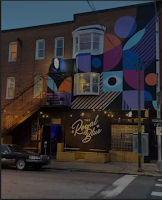Baltimore Museum of Art's Textile Collection
I am a Junior Fiber Major with concentrations in Experimental Fashion and Photography. From
May-August 2013 I was the intern for the Baltimore Museum of Art's Textile Collection. I found an
initial listing for the internship on www.micanetwork.com then went to the BMA's official website to
find all the details and application process. I submitted a cover letter, resume, and had a phone
interview with the then assistant curator, Julie.
The Baltimore Museum of Art is a public art museum that boasts a very large collection of all
mediums. The museum is currently under renovation which changed a bit of what I worked on. The
textile gallery was part of the renovation so I did not assist with any exhibitions.
My main presence was in the Textiles Collection working with the thousands of textiles in the
vault with my supervisor Anita Jones, the Head Curator for the Textile Collection. I worked on multiple projects throughout my time there. My first project was logging information about a set of sewing tools from the early 1900's into The Museum System. The Museum System is the data base that has all of the pieces in the museum logged with important information such as size, medium, artist, origin, etc. I then moved onto helped with a large collection of lace called the Bliss Laces. I helped with researching them and locating them within the vault. The National Gallery in Washington, DC, had borrowed two of our William Morris textiles. When they were returned to uwe had to unroll them and do a condition report with the head conservator, Christine Downie. I then took on the responsibility of locating, photography, and logging the collection of Turkish textiles within the whole collection. This surmounted to over 200 embroidered towels, large clothes, regalia, and accessories. This information was all compiled for a review of all the Turkish textiles that would be happening by a specialist in late August. I am most proud of the work I did on the Turkish textile project. It was an extremely large project and I was able to complete it in my time there. Those images I took are now the images used in the Museum System database.

The most valuable information I learned from this experience deals with two things. I learned a
lot of history of textiles. I will never look at a piece of lace or embroidery the same way again. I alsolearned a lot about how a museum works. There is a definite hierarchy and a lot of office politics. This is especially present at the BMA because it is a non-profit, public, governmentally funded museum. It hasn't altered my career path or been directly connected to it as I still plan to pursue costume design. My design will definitely be more historically-conscious, though, and I am more aware of different fabric treatments now.
May-August 2013 I was the intern for the Baltimore Museum of Art's Textile Collection. I found an
initial listing for the internship on www.micanetwork.com then went to the BMA's official website to
find all the details and application process. I submitted a cover letter, resume, and had a phone
interview with the then assistant curator, Julie.
The Baltimore Museum of Art is a public art museum that boasts a very large collection of all
mediums. The museum is currently under renovation which changed a bit of what I worked on. The
textile gallery was part of the renovation so I did not assist with any exhibitions.
My main presence was in the Textiles Collection working with the thousands of textiles in the
vault with my supervisor Anita Jones, the Head Curator for the Textile Collection. I worked on multiple projects throughout my time there. My first project was logging information about a set of sewing tools from the early 1900's into The Museum System. The Museum System is the data base that has all of the pieces in the museum logged with important information such as size, medium, artist, origin, etc. I then moved onto helped with a large collection of lace called the Bliss Laces. I helped with researching them and locating them within the vault. The National Gallery in Washington, DC, had borrowed two of our William Morris textiles. When they were returned to uwe had to unroll them and do a condition report with the head conservator, Christine Downie. I then took on the responsibility of locating, photography, and logging the collection of Turkish textiles within the whole collection. This surmounted to over 200 embroidered towels, large clothes, regalia, and accessories. This information was all compiled for a review of all the Turkish textiles that would be happening by a specialist in late August. I am most proud of the work I did on the Turkish textile project. It was an extremely large project and I was able to complete it in my time there. Those images I took are now the images used in the Museum System database.

The most valuable information I learned from this experience deals with two things. I learned a
lot of history of textiles. I will never look at a piece of lace or embroidery the same way again. I alsolearned a lot about how a museum works. There is a definite hierarchy and a lot of office politics. This is especially present at the BMA because it is a non-profit, public, governmentally funded museum. It hasn't altered my career path or been directly connected to it as I still plan to pursue costume design. My design will definitely be more historically-conscious, though, and I am more aware of different fabric treatments now.



